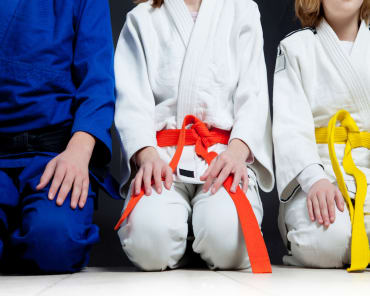When you step onto the mats in a Brazilian Jiu-Jitsu (BJJ) gym, you're entering a space that fosters learning, respect, and camaraderie among practitioners. Understanding mat etiquette is essential for creating a positive training environment and ensuring that everyone feels welcome and safe. While many of these rules may seem unwritten, they are critical to maintaining a respectful and effective learning atmosphere. In this guide, we'll explore the key aspects of mat etiquette, from the moment you walk into the gym to your interactions with fellow students and instructors.
1. Arrive on Time
Punctuality is a fundamental aspect of mat etiquette. Arriving on time shows respect for your instructor, your training partners, and the class as a whole. When you arrive late, you disrupt the flow of the class and can miss essential warm-up exercises and technique demonstrations. If you do find yourself running late, it’s best to wait until a suitable break or transition before joining the class, and always apologize to your instructor afterward.
Tips for punctuality:
- Plan your route and allow extra time for travel.
- Arrive early to stretch, warm up, and mentally prepare for the class.
- If you must arrive late, enter quietly and position yourself in a way that minimizes disruption.
2. Bow When Entering and Exiting the Mat
Bowing is a traditional practice in martial arts that signifies respect for the space and those who train within it. When you step onto or off the mats, bow to acknowledge the training area and the people present. This simple act demonstrates your appreciation for the art of Jiu-Jitsu and helps foster a respectful environment.
How to bow:
- Stand with your feet together and your arms at your sides.
- Lower your torso slightly, keeping your head up and eyes forward.
- Hold this position briefly before returning to an upright posture.
3. Respect Your Instructor and Fellow Students
Respect is the cornerstone of any martial arts practice, and Jiu-Jitsu is no exception. Always show respect to your instructor by listening attentively during class, asking questions when appropriate, and following their guidance. Likewise, treat your training partners with respect—both on and off the mats.
Ways to demonstrate respect:
- Address your instructor and training partners with proper titles (e.g., Professor, Coach, or Mr./Ms.) as a sign of respect.
- Avoid talking while the instructor is demonstrating a technique.
- Offer constructive feedback to your training partners and accept feedback graciously.
4. Keep the Mat Clean and Tidy
Maintaining cleanliness on the mats is crucial for the health and safety of all practitioners. Always arrive with clean gi or training attire, and avoid training if you're sick or have open wounds. Additionally, be mindful of your personal hygiene; shower before class and ensure your fingernails and toenails are trimmed to prevent injury.
Tips for mat cleanliness:
- Wipe down your feet before stepping onto the mats to remove dirt and debris.
- Bring a clean gi or training attire for every session, and wash your gear regularly.
- If you sweat excessively, consider using a towel to wipe down the mats after rolling, especially if you're in a shared training space.
5. Be Mindful of Personal Space
Jiu-Jitsu is an intimate martial art that involves close physical contact. However, it’s important to respect personal space when waiting for your turn to roll or during drills. Avoid crowding your training partners and give them room to move comfortably. This consideration helps create a safer training environment and minimizes the risk of injury.
How to be mindful of personal space:
- Maintain a respectful distance when observing drills or waiting for your turn to roll.
- Communicate with your partner if you need to adjust your positioning during practice.
- Be aware of your surroundings to avoid unintentionally bumping into others.
6. Know When to Tap and Respect Taps
Tapping is a vital aspect of Jiu-Jitsu that signifies submission and the end of a roll or technique. Knowing when to tap—whether you’re feeling discomfort, pain, or your opponent has successfully secured a submission—is crucial for your safety. Additionally, it’s equally important to respect your training partner’s tap; once they tap, release immediately to prevent injury.
Guidelines for tapping:
- Tap verbally or physically (e.g., tapping the mat or your partner) when you feel you can no longer escape a submission or are in discomfort.
- Never hesitate to tap, as your safety is more important than winning a roll.
- Upon receiving a tap from your partner, immediately release the hold and check in to ensure they’re okay.
7. Communicate with Your Training Partners
Effective communication is essential for a safe and productive training environment. Before rolling, discuss any specific goals or concerns with your partner. Let them know if you’re working on a particular technique, or if you prefer to take it easy or go hard during sparring.
Tips for communication:
- Be clear about your intentions and what you hope to achieve during a roll.
- If something feels off during sparring, speak up and adjust your intensity or technique.
- After rolling, provide constructive feedback and ask for feedback in return.
8. Support Your Training Partners
Jiu-Jitsu is not just about individual progress; it’s also about fostering a supportive community. Encourage your training partners, celebrate their successes, and offer help when they’re struggling. A positive training atmosphere not only enhances everyone’s experience but also contributes to individual growth.
Ways to support your partners:
- Offer tips and advice to help your partners improve their technique.
- Cheer them on during sparring or competitions, and be genuinely happy for their achievements.
- Share your own experiences and challenges to build camaraderie and trust among training partners.
Conclusion
Understanding and practicing mat etiquette is essential for creating a respectful and supportive environment in Brazilian Jiu-Jitsu. By adhering to these unwritten rules—arriving on time, showing respect, maintaining cleanliness, and communicating effectively—you contribute to a positive training atmosphere for yourself and your fellow practitioners. Mat etiquette is not just about following rules; it’s about fostering a sense of community, respect, and shared growth in the art of Jiu-Jitsu. So, as you step onto the mats, remember that your actions and attitude play a crucial role in shaping the culture of your gym and the overall experience for everyone involved.






